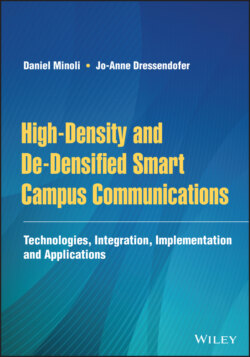High-Density and De-Densified Smart Campus Communications

Реклама. ООО «ЛитРес», ИНН: 7719571260.
Оглавление
Daniel Minoli. High-Density and De-Densified Smart Campus Communications
Table of Contents
List of Tables
List of Illustrations
Guide
Pages
HIGH‐DENSITY AND DE‐DENSIFIED SMART CAMPUS COMMUNICATIONS. Technologies, Integration, Implementation, and Applications
PREFACE
ABOUT THE AUTHORS
ACKNOWLEDGMENTS
1 Background and Functional Requirements for High‐Density Communications
1.1 BACKGROUND
1.2 REQUIREMENTS FOR HIGH‐DENSITY COMMUNICATIONS
1.2.1 Pre‐pandemic/Long‐term Requirements for Airports
1.2.2 Pre‐pandemic/Long‐term Requirements for Stadiums
1.2.3 Pre‐pandemic/Long‐term Requirements for Convention Centers
1.2.4 Pre‐pandemic/Long‐term Requirements for Open Air Gatherings and Amusement Parks
1.2.5 Pre‐pandemic/Long‐term Requirements for Classrooms
1.2.6 Pre‐pandemic/Long‐term Requirements for Train and Subway Stations
1.2.7 Pre‐pandemic/Long‐term Requirements for Dense Office Environments
1.2.8 Ongoing Requirements for Dense Smart Warehouses and Distribution Centers
1.2.9 Pre‐pandemic/Long‐term Requirements for Dense Smart Cities
1.3 PANDEMIC‐DRIVEN SOCIAL DISTANCING
1.3.1 Best Practices
1.3.2 Heuristic Density for the Pandemic Era
1.4 THE CONCEPT OF A WIRELESS SuperNetwork
REFERENCES
Notes
2 Traditional WLAN Technologies
2.1 OVERVIEW
2.2 WLAN STANDARDS
2.3 WLAN BASIC CONCEPTS
2.3.1 PHY Layer Operation
2.3.2 MAC Layer Operation
2.4 HARDWARE ELEMENTS
2.5 KEY IEEE 802.11AC MECHANISMS
2.5.1 Downlink Multi‐User MIMO (DL‐MU‐MIMO)
2.5.2 Beamforming
2.5.3 Dynamic Frequency Selection
2.5.4 Space–Time Block Coding
2.5.5 Product Waves
2.6 BRIEF PREVIEW OF IEEE 802.11AX
REFERENCES
Notes
3 Traditional DAS Technologies
3.1 OVERVIEW
3.2 FREQUENCY BANDS OF CELLULAR OPERATION
3.2.1 Traditional RF Spectrum
3.2.2 Citizens Broadband Radio Service (CBRS)
3.2.3 Freed‐up Satellite C‐Band
3.2.4 5G Bands
3.2.5 Motivations for Additional Spectrum
3.2.6 Private LTE/Private CBRS
3.2.7 5G Network Slicing
3.2.8 Supportive Technologies
3.3 DISTRIBUTED ANTENNA SYSTEMS (DASs)
3.3.1 Technology Scope
Indoor Usage
Campus Usage
Outdoor Carrier Usage
3.3.2 More Detailed Exemplary Arrangement
3.3.3 Traffic‐aware DAS
3.3.4 BBU and DAS/RRU Connectivity
3.3.5 Ethernet/IP Transport Connectivity of DAS
REFERENCES
Notes
4 Traditional Sensor Networks/IoT Services
4.1 OVERVIEW AND ENVIRONMENT
4.2 ARCHITECTURAL CONCEPTS
4.3 WIRELESS TECHNOLOGIES FOR THE IoT
4.3.1 Pre‐5G Wireless Technologies for the IoT. Local Level
WAN Level
4.3.2 NB‐IoT
4.3.3 LTE‐M
4.3.4 5G Technologies for the IoT
4.3.5 WAN‐Oriented IoT Connectivity Migration Strategies
4.4 EXAMPLES OF SEVEN‐LAYER IoT PROTOCOL STACKS
4.4.1 UPnP
4.4.2 ZigBee
4.4.3 Bluetooth
4.5 GATEWAY‐BASED IoT OPERATION
4.6 EDGE COMPUTING IN THE IoT ECOSYSTEM
4.7 SESSION ESTABLISHMENT EXAMPLE
4.8 IoT SECURITY
4.8.1 Challenges
4.8.2 Applicable Security Mechanisms
4.8.3 Hardware Considerations
Trusted Execution Environment
Intel TXT
4.8.4 Other Approaches: Blockchains
REFERENCES
Notes
5 Evolved Campus Connectivity
5.1 ADVANCED SOLUTIONS
5.1.1 802.11ax Basics
5.1.2 Key 802.11ax Processes
5.1.3 Summary
5.2 VOICE OVER Wi‐Fi (VoWi‐Fi)
5.3 5G TECHNOLOGIES
5.3.1 Emerging Services
5.3.2 New Access and Core Elements
5.3.3 New 5GC Architecture
5.3.4 Frequency Spectrum and Propagation Challenges
5.3.5 Resource Management
5.3.6 Requirements for Small Cells
5.3.7 Comparison to Wi‐Fi 6
5.4 IoT
5.5 5G DAS SOLUTIONS
5.6 INTEGRATED SOLUTIONS
REFERENCES
Notes
6 De‐densification of Spaces and Work Environments
6.1 OVERVIEW
6.2 BASIC APPROACHES
6.3 RTLS METHODOLOGIES AND TECHNOLOGIES
6.3.1 RFID Systems
6.3.2 Wi‐Fi‐based Positioning System (WPS)
6.3.3 Bluetooth
6.3.4 UWB
6.3.5 Automatic Vehicle Location (AVL)
6.4 STANDARDS
6.5 APPLICATIONS
REFERENCES
Notes
7 UWB‐Based De‐densification of Spaces and Work Environments
7.1 REVIEW OF UWB TECHNOLOGY
7.2 CARRIAGE OF INFORMATION IN UWB
7.2.1 Pulse Communication
7.2.2 UWB Modulation
7.3 UWB STANDARDS
7.4 IoT APPLICATIONS FOR UWB
7.5 UWB APPLICATIONS FOR SMART CITIES AND FOR REAL‐TIME LOCATING SYSTEMS. 7.5.1 Applications for Smart Cities
7.5.2 UWB Applications to Real‐Time Location Systems
7.6 OSD/ODCMA APPLICATIONS
REFERENCES
Note
8 RTLSs and Distance Tracking Using Wi‐Fi, Bluetooth, and Cellular Technologies
8.1 OVERVIEW
8.2 RF FINGERPRINTING METHODS
8.3 Wi‐Fi RTLS APPROACHES. 8.3.1 Common Approach
8.3.2 Design Considerations
8.3.3 Drawbacks and Limitations
8.3.4 Potential Enhancements
8.3.5 Illustrative Examples
Cisco Systems Traditional RTLS
Cisco Meraki and Meraki Marketplace
8.4 BLE. 8.4.1 Bluetooth and BLE Background
8.4.2 RTLS Applications
8.4.3 BLE‐Based Contact Tracing
8.4.4 Illustrative Examples
AiRISTA Flow
Mist (Juniper Networks) Virtual Bluetooth Beacon Technology
8.5 CELLULAR APPROACHES
8.6 SUMMARY
REFERENCES
Note
9 Case Study of an Implementation and Rollout of a High‐Density High‐Impact Network
9.1 THURGOOD MARSHALL BWI AIRPORT DESIGN REQUIREMENTS
9.1.1 Broad Motivation
9.1.2 Status Quo Challenges
9.1.3 RFP Requirements
9.2 OVERVIEW OF THE FINAL DESIGN
9.2.1 DAS Solutions
9.2.2 Broadband, BLE, IoT
Mist Wi‐Fi and Bluetooth Access Points
Mist Cloud with Marvis AI
Security
Note
10 The Age of Wi‐Fi and Rise of the Wireless SuperNetwork (WiSNET)
10.1 WHAT PRECEDED THE WiSNET
10.2 WHAT COMES NEXT
10.3 THE SUPER‐INTEGRATION CONCEPT OF A WIRELESS SUPERNETWORK (WiSNET)
10.4 THE MULTIDIMENSIONALITY OF A SUPERNETWORK (WiSNET)
10.5 THE GENESIS OF THE WiSNET CONCEPT DEFINED IN THIS TEXT
10.6 THE DEFINITION AND CHARACTERIZATION OF A WiSNET
10.6.1 Architectural Aspects of a WiSNET
Unified Architecture
Open, Integrated, Unified Platform, and Access Technology
Wi‐Fi/IP Centric
Consistent Core Technology
Unified Administration
Secure Environment
Service Richness and Elasticity
IoT‐empowered Ecosystem
Service Availability
Simple Scalability
10.6.2 Technology Aspects of a WiSNET
Voice‐related Services
Data‐related Services
WAN‐related Services
Building Management‐related Services
Cloud‐supported Services
Video‐related Services
Artificial‐related Services
10.6.3 Management Aspects of a WiSNET
Administration
Monitoring
Provisioning
Policy Enforcement
Security Assurance
Technology Vendor and Core Provider Management
Service Definition
Technology Evolution
User Support and Control
Revenue Generation and Collection
10.7 ECONOMIC ADVANTAGES OF A WiSNET SYSTEM
10.8 5G SLICE CAPABILITIES
10.8.1 Motivations and Approaches for 5G Network Slicing
10.8.2 Implementation
10.8.3 Wi‐Fi Slicing
10.9 CONCLUSION
REFERENCES
Notes
INDEX
WILEY END USER LICENSE AGREEMENT
Отрывок из книги
Daniel Minoli
.....
Office space represents a major environment where work is accomplished in the United States and around the world. Data from the Commercial Buildings Energy Consumption Survey indicates that there were 5.6 million commercial buildings in the United States in 2012 (the most recent year for which data are available), spanning 87.4 billion ft2 of floorspace (see Figure 1.3) [13, 14]. The typical space allocation per employee is 130–150 ft2, although some lower‐end industries (e.g. retail) allocate less and some higher‐end industries (e.g. law firms) allocate more.
TABLE 1.9 Top Subway and Rapid Transit Systems in the United States
.....